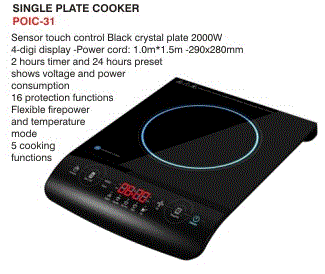
Induction Stove is ideal for any kitchen. While cooking 64% faster, you save up-to 52% on electricity!
An induction cooker uses a type of induction heating for cooking. It is chiefly distinguished from other common forms of stovetop cooking by the fact that the heat is generated directly in the cooking vessel, as opposed to being generated in the stovetop by electrical coils or burning gas. ...
But with induction cooking the heat level is every bit as instantaneous--and as exact--as with gas, yet with none of the many drawbacks of gas (which we will detail later). Induction elements can be adjusted to increments as fine as the cooker maker cares to supply, just like gas, and--again very important to serious cooks--such elements can run at as low a cooking-heat level as wanted for gentle simmering and suchlike (something even gas is not always good at). Someday, perhaps not so many years away, the world will look back on cooking with gas as we today look on cooking over a coal-burning kitchen stove.
As a comparison, 40%--less than half--of the energy in gas gets used to cook, whereas with induction 84% percent of the energy in the electricity used gets used to cook (and the rest is not waste heat as it is with gas). There are two important heat-related consequences of that fact:
cooler kitchens: of course the cooking vessel and the food itself will radiate some of their heat into the cooking area--but compared to gas or other forms of electrically powered cooking, induction makes for a much cooler kitchen (recall the old saying: "If you can't stand the heat, get out of the kitchen."); and,
- a cool stovetop: that's right! The stovetop itself barely gets warm except directly under the cooking vessel (and that only from such heat as the cooking vessel bottom transfers). No more burned fingers, no more baked-on spills, no more danger with children around. (The photo at the right--one of several similar ones to be found on the web--shows, like the one above, how only the cooking vessel does the actual cooking.)


